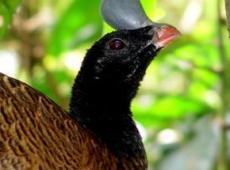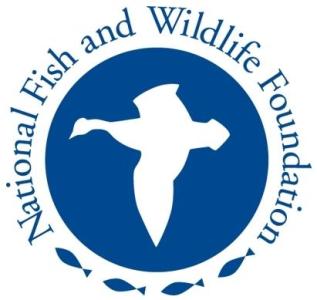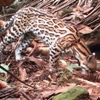Establishment: The Helmeted CurassowBird Reserve was established in May 2007 in order to conserve the habitat of the Northern Helmeted Curassow(Pauxi pauxi) and other endemic species of importance to the area. The Northern Helmeted Curassowis a bird of the rain forest and cloud forest, classified as vulnerable to extinction by the IUCN and is endemic to Colombia and Venezuela. In Colombia it is only found in the Serranía del Perijá and the Cordillera Oriental. Location and Area: Located in the Cerro la Paz in the Cordillera Oriental of the Andes, in the towns of San Vicente de Betulia and Chucurí, Santander department, about an hour and a half from the suburbs of the town of San Vicente de Chucurí and two and a half hours from the city of Bucaramanga. It has an area of 4,792 acres, in an altitudinal range between 600 and 1,500 meters above sea level.(See map). Biological importance: Among the most important birds on the reserve are the Northern Helmeted Curassow(Pauxi pauxi) in a vulnerable state, the Chestnut-Bellied Hummingbird (Amazilia castaneiventris), critically endangered, Blue-billed Curassow (Crax alberti), critically endangered, the Saffron-headed Parrot (Pionopsitta pyrilia), in a vulnerable state, the White-mantled Barbet (Capito hypoleucus) in danger, the Sooty Ant-tanager (Habia gutturalis), vulnerable, and Cerulean Warbler (Dendroica cerulea) vulnerable, among others. The reserve’s forests also have a high diversity of mammals, among which are the spectacled bear (Tremarctos ornatus), tatabros, Borugos, ocelots, monkeys, squirrels, armadillos, anteaters (tamandúas), deer and foxes. The predominant flora is the oil boiler, the Colombian Mahogany, tagua, arbutus, Guacharacos and points. Climate: It is located in the intertropical convergence zone and therefore makes for a hot and humid tropical climate. Presents an average temperature of 27.8 ° C. Biophysical characteristics: Approximately 90% of its length corresponds to tropical rainforest and 10% coffee, cocoa and paddocks on a small scale. The area has steep slopes with large hollows, big canyons and two regimens of rain and drought. The main gorge is the Putana, into which enter the gorges of la Vergela, las Pailas, la Boquerona, la Mantecosa, Caño Manso y la Aguamieluda. Condition: Ecological restoration, conservation easements and Silvopastoral. Facilities: Accommodation for four people, electricity and drinking water. Attractions: The main attraction of this reserve is, without doubt, its biodiversity, it also has the Lengerke historic trail, made of stone in 1840 by the German merchant Von Lengerke Geo. It has a high number of streams and beautiful landscapes. General recommendations
Income and visits: Email: visit@conservation.co and fundacion@proaves.org With the support of:
Related news
Critical expansion for the Pauxi pauxi Reserve Because of the significant threats to biodiversity and natural resources in Cerro de la Paz (Santander), especially freshwater for the city of Barrancabermeja, ProAves has acquired and protecting 330 acres of private forested lands earmarked for timber and pasturelands to expand the Pauxi pauxi Reserve.
New Reserve for threatened Helmeted Curassow In order to conserve the habitat of the Helmeted Curassow and other important endemic species of the Eastern Cordillera of Colombia, ProAves, thanks to the support of American Bird Conservancy (ABC), National Fish and Wildlife Foundation (NFWF) and ConocoPhillips, created the Helmeted Curassow Natural Bird Reserve in Cerro de la Paz, department of Santander.
|
Fundación ProAves – por la conservación en el país de las aves





